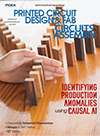News
News
Reworking Pb-Free PCBs
Published: 25 September 2008
by American Competitiveness Institute
Proper preheat and cleaning techniques are essential.
The transition process (Table 1) presents a daunting number of possible permutations of board finishes, component finishes and solder alloys that may manifest in an assembly operation, often when inconvenient. Engineers, operators and technicians must be cognizant of the different manufacturing parameters for producing Pb-free assemblies and any subsequent rework.

Hand soldering. One more common, yet oft-overlooked, problem in reworking a Pb-free solder joint is preheating substrates prior to applying the soldering iron to the joint area. Preheating will reduce the contact time of the soldering tip to the joint, which will mitigate localized overheating of the underlying pad. A controlled temperature hot plate is a recommended tool for preparing the substrate for Pb-free soldering. The following conditions can be used for soldering SAC 305 (Sn 96.5%, Ag 3.0%, Cu 0.5%):
Preheat temperatures: 100° to 125°C.Another important aspect of securing a successfully reworked solder joint is to ensure total cleanliness of the area to be reworked. This includes using clean soldering tips and removing old solder from both the component and pad area. Contamination of the newly applied solder will lead to oxide formation that will prevent proper wetting and bonding. Often, to compensate for difficulty in applying a proper fillet, an operator may affix the soldering iron in the pad area for an excessive period, causing substrate delamination. It is important to remember tip temperatures are considerably higher for Pb-free soldering. Compensating with additional flux is not a panacea to correct improper technique and incorrect soldering parameters. Excessive flux can lead to cleaning difficulties and disproportionate formation of solder voids from volatile flux residuals.
Soldering tip temperature: 345°C.
Tip dwell times: Fewer than 2 sec.
BGA rework. Among the common areas where the transitional phase from SnPb to Pb-free will impact production and quality is in the placement of mixed solder BGAs. We have encountered numerous applications where a paste and BGA solder alloy mismatch has led to cold solder joints. For example, the operator presets their profile to accommodate a eutectic paste alloy, while applying a SACB (SnAgCuBi) solder ball, resulting in a non-collapsed BGA (Figure 1).

In such situations, it is recommended the higher melt alloy profile be used to induce homogeneity in the formation of the solder. Temperatures are typically 30°-40°C higher at the liquidus peak than eutectic SnPb. Keep in mind the desired peak temperature of the alloy can be substantially higher than its melting point, and will depend on the efficiency of the reflow system to handle the gradient heat effect.
For applications in which a stenciled paste deposit is not warranted or prohibitive, a tacky flux (which incorporates mixtures of flux and residual amounts of alloy) can be substituted. The profile, as exemplified in a typical BGA rework station, should have the appropriate zone parameters at the preheating, soak and liquidus stages. As in any reflow process, it is imperative a test board be sacrificed so that a proper profile can be developed. This is done by creating a “temperature envelope” around and directly under the BGA through strategic placement of thermocouples. This will ensure temperature uniformity is achieved across the zone of interest, and no adjacent components are adversely affected by excessive heat.
The American Competitiveness Institute (aciusa.org) is a scientific research corporation dedicated to the advancement of electronics manufacturing processes and materials for the Department of Defense and industry. This column appears monthly.
Press Releases
- Trilogy-NET Adds Second Vapor Phase Reflow System to Expand High-Precision Manufacturing
- Federal Electronics Invests in HydroJet Inline Cleaning Technology at Hermosillo Facility
- Seika Machinery to Host Webinar on Wireless Strain Measurement for PCB Testing
- NEPCON ASIA 2025: Innovating Smart Manufacturing Ecosystems and Bridging Global Opportunities







